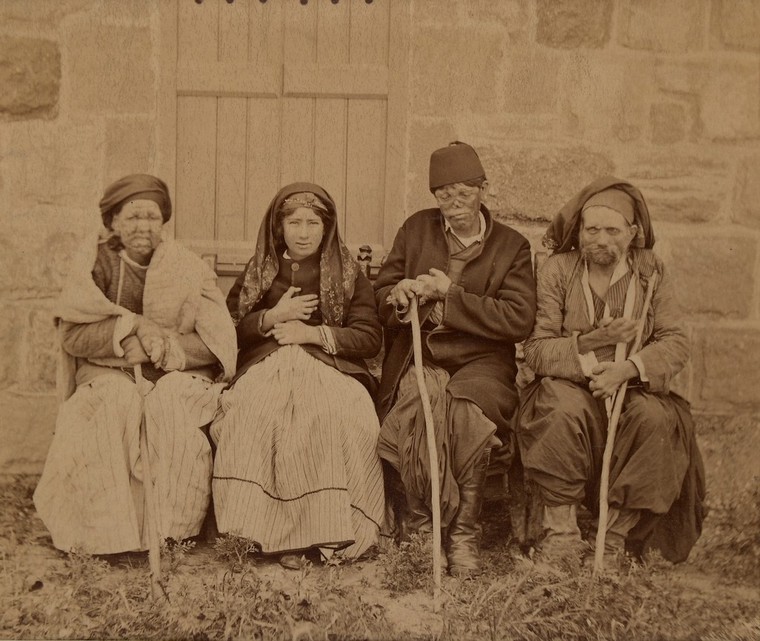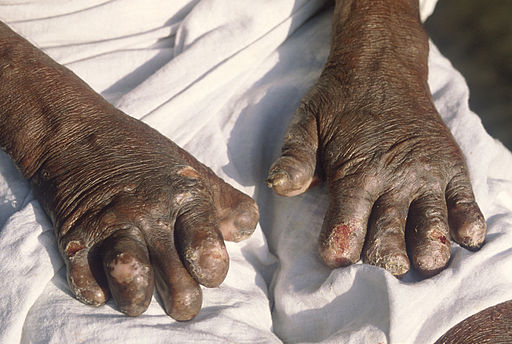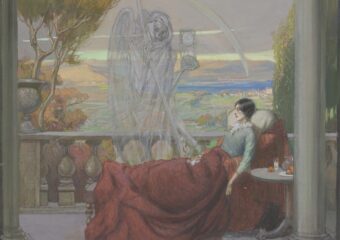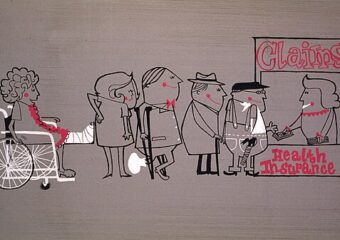Leprosy, otherwise known as “Hansen’s disease,” has drawn the attention of writers and artists, and scientists and scholars for thousands of years going back to ancient civilizations. Early on, they represented leprosy as a diverse range of mostly skin lesions resulting in separation of sufferers from the public for fear of contagion, public health concerns, exposure to unsightly and unsettling disfigurement, and various religious and secular interpretations. Over time, and closer to modern day, the evolution of pathological anatomy and germ theory established the bacteria, Mycobacterium leprae, as the cause of leprosy. Leprosy then became a treatable infectious disease, though stigma around it persists in different parts of the world.
Leprosy is categorized as a “neglected tropical disease,” but is no longer considered a public health problem according to the World Health Organization (WHO). However, leprosy still strikes; every year, two-hundred-thousand new cases occur in one-hundred-twenty countries, and India accounts for more than half. The availability of effective treatments for leprosy have dramatically lessened the disfiguring manifestations it can cause, but when disfiguration occurs, stigma, discrimination, and prejudice can result.
A recent novel featuring leprosy in the southwestern region of India occasions the opportunity to compare a literary description of the disease with contemporary biomedical text. What follows are excerpts from a classic biomedical text and a recently-published literary novel, for the purpose of comparing how they describe clinical manifestations of leprosy, and for considering how these two forms can work as companion sources.
The Biomedical
From: Richardus JH, Kar HK, Bakirtzief Z, van Brakel WH. Leprosy. In: Loscalzo J, Fauci A, Kasper D, Hauser S, Longo D, Jameson J. eds. Harrison’s Principles of Internal Medicine, 21e. McGraw Hill; 2022. Accessed December 06, 2023.
Excerpts
General Background:
Leprosy, also referred to as Hansen’s disease, is a chronic infectious disease caused by Mycobacterium leprae. The clinical manifestations are largely confined to the skin, peripheral nervous system, eyes, and upper respiratory tract. The differing immune responses to M. leprae result in a spectrum of disease ranging from tuberculoid to lepromatous leprosy. M. leprae has a predilection for peripheral nerves, and immunologically mediated reactional states can cause nerve damage to the face, arms, and legs; this damage often results in disability, which in turn can lead to stigma and social exclusion. The physical disfigurement that accompanies leprosy has left marks on society that have endured long after the disease’s disappearance in many countries. In everyday language, leprosy has become a metaphor for a horrible condition that warrants social exclusion.
Chapter 179
Whatever the route of M. leprae’s entry into the human body, the pathogenic process usually starts in the peripheral nerves. Once bacilli are engulfed by Schwann cells, the histopathologic changes in nerve and skin—and thus the type of leprosy that develops—depend on the immunologic resistance of the person infected, in particular on the cell-mediated immune (CMI) response to the bacillus and its antigens.
Clinical Manifestations:
Leprosy is a disease affecting mainly the skin, cutaneous and peripheral nerves, mucous membranes, and, less commonly, other sites such as joints, lymph nodes, eyes, and testes. Other systemic manifestations may occur, particularly in BL and LL disease, with or without leprosy reactions. Most dermal and cutaneous nerves feeding skin lesions are affected—e.g., the supraorbital, great auricular, radial cutaneous, infrapatellar, superficial fibular, and sural nerves and the cutaneous nerves of the thigh. The peripheral nerves involved include the ulnar, median, radial (in upper limbs), lateral popliteal, and posterior tibial (in lower limbs). The cranial nerves commonly involved are the trigeminal and facial.
Chapter 179
The Literary

From The Covenant of Water, 2023, Abraham Verghese, Grove Press, New York.
The novel is set in the Kerala region in the very southwestern part of India over the years from 1900 to 1977. The central story follows a family beginning with Big Ammachi, as she will come to be known, at the time she is wed at age twelve to a man of forty years. She prematurely enters adulthood situated in a society that divides and stigmatizes people by colonial rule, castes, religions, diseases, wealth, and geography water determines.
Through three generations, family members, their workers, and people in their social circles confront dreadful illnesses and serious and mortal accidents. Indeed, in each generation, someone in the family drowns, and when mapped on a genealogical tree, a hereditary relationship appears. The cause is given a name, “The Condition,” which can become evident in family members at an early age enabling protective measures met with varying success. The pathophysiology and the biomedical classification for The Condition are revealed late in the book.
The author, Abraham Verghese is a physician and writer, and so it should come as no surprise that he folds illnesses and injuries into this book as well as his others. But, they are not included in any gratuitous fashion; they often have purposes that are plot related and, seemingly, meant to enlighten and educate health professionals on issues ranging from clinical diagnosis to compassionate care and empathy for the suffering. He also highlights the link between illness and destiny for any given person; the obstacles illness creates for people getting through their lives.
Thus, as could be expected, characters in The Covenant of Water are challenged with several different illnesses and injuries, involving specifically, leprosy, diphtheria, typhoid, cretinism, aortic aneurysm, and opioid addiction in addition to The Condition. Leprosy comes into play in the novel through a leprosarium, which serves as a crossroads for several characters and their stories to take shape. The leprosarium also gives Verghese opportunities to highlight stigmas that accompany certain diseases and to make his points about compassionate care and clinical diagnosis.
Excerpts
A tapping sound gets louder. Rune [a physician at the leprosarium] sees a shape shuffling along, a staff in one hand, silhouetted by moonlight. The flattened profile, the absent nose are immediately recognizable: a leprous facies. Stumps, not fingers, clutch the staff. Coins rattle in a tin cup dangling from the neck.
p. 196
‘I used to be a carpenter, [Sankar, a resident of the leprosarium, says]’ He is short two fingers on the right and the rest are clawed. The flesh of the palm is wasted, giving the hand a simian appearance. The left has all its fingers, but the index and middle stick out in a gesture of papal benediction.
p. 200
Sankar was a new father when he noticed a welt on his face, then more over the ensuing months. His hands turned numb. ‘I couldn’t hold my carpenter’s pencil. My wife’s brother threw me out. The whole village threw stones at me. My wife watched…Leprosy deadens the nerves and is therefore painless; the real wound of leprosy, and the only pain they feel, is that of exile.
p 201
Rune was taught that leprosy is rarely contagious. The causative bacterium lives in the environment, more so in unclean settings, but only those with unique susceptibility get the disease. (p. 201)
p. 201
Rune has noted in his residents…[a] perverse pride: their ‘advantage’ over those who rejected them is that they can walk forever; and they can also stand like statues for hours, having no need to shift weight from one foot to the other because they have no discomfort. The cumulative trauma of walking on injured feet and of prolonged standing, inflames, stretches, and ultimately ruptures the ligaments that hold the bones of the foot together. When the talus—the saddle-shaped bone under the tibia that transfers body weight to the heel—finally collapses, the arch of the foot becomes as flat as an appam, then convex, like the bottom of a rocking chair. The body weight is no longer spread over the entire foot but concentrated on one spot, and a pressure-ulcer results. If neglected, the ulcer grows and turns gangrenous, forcing Rune to amputate. But it never hurts.
p. 207

Attribution 4.0 International (CC BY 4.0)
Source: Wellcome Collection.
Also:
Title image attribution: B.jehle, CC BY-SA 3.0



